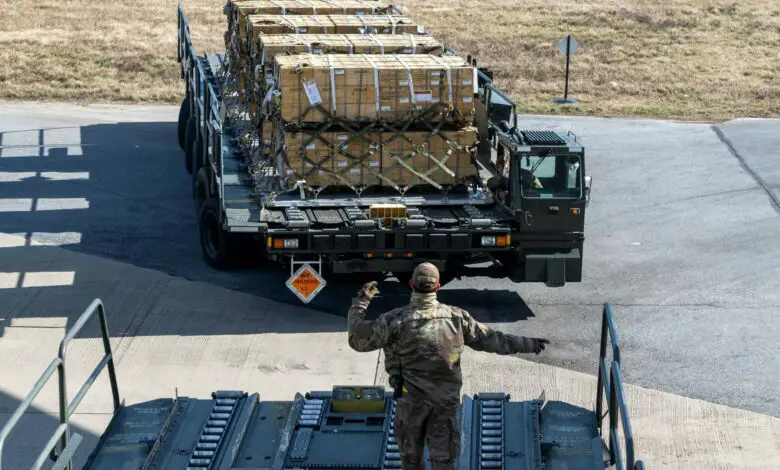
For the better part of two years, the US and other Western democratic nations relied on two main arguments for supporting Ukraine.
The first revolves around a moral obligation to defend an emerging democracy suffering from an illegal invasion at the hands of a more powerful neighbor.
The second highlights two interconnected strategic imperatives. President Vladimir Putin will not stop in Ukraine if he succeeds, which may lead to a Russian invasion of other European or even NATO countries. Furthermore, potential aggressor states, such as China, may be encouraged to use force to achieve their objectives if Moscow succeeds.
Aid as Investment
Both of these arguments resonate with many throughout the Western world, but the second is increasingly ineffective in convincing people already skeptical of supporting Ukraine.
The idea that a Russian victory in Ukraine will lead to another invasion elsewhere or encourage China to invade Taiwan may be plausible, but it is theoretical and sits at the geopolitical and strategic level of thinking.
Relying on future theoretical possibilities instead of concrete realities is unlikely to change the minds of those increasingly against further aid for Kyiv. Instead, pro-Ukraine leaders within the US should use messaging strategies to target the population increasingly wary of America’s leading role in the world and those who view alliances and partnerships on a transactional basis.
These strategies would underscore the direct benefits of aiding Ukraine instead of promoting support on a moral or strategic basis. This can be done by framing aid as an investment rather than allowing a narrative that portrays assistance as money that US taxpayers are sending to another nation without benefit.

Cost-Benefit Analysis
To gauge whether Washington should continue aiding Ukraine, the costs the government incurs and the return on investment it receives can be evaluated.
The US incurs a monetary cost of only a fraction of the Department of Defense budget. The national defense budget is $841.4 billion, and since Russia’s invasion, the US has provided $74.3 billion to Kyiv. In relative terms, it spent less than 0.5 percent of its GDP on aid to Ukraine.
The argument that the US receives an overwhelmingly positive non-monetary return on investment from aiding Kyiv is multifaceted.
Degradation of Russia’s Armed Forces
The first argument is based on the idea that Russia is a proximate power on the global scale.
The Pentagon’s mission is to provide the military forces needed to deter war and ensure the nation’s security. With this mission and the comparatively minuscule cost of aiding Ukraine in mind, Washington has assisted Kyiv in countering a near-peer foreign adversary in an increasingly complex geopolitical environment.
For approximately 8.8 percent of the annual defense budget over the past two years, one of America’s two main adversaries has reportedly suffered over 300,000 casualties and lost tens of thousands of pieces of equipment.
In this process, there has not been a single US military casualty. In contrast, Russia’s army has been decimated and will likely take years to recover.
Washington’s return on investment is the degradation of Russia’s armed forces, a major strategic priority for a fraction of the cost of an annual defense budget.

US Defense Industrial Base
The second return on investment is that the aid has exposed the weakened state of the US defense industrial base.
The Presidential Drawdown Authority allows for the rapid delivery of defense articles from preexisting equipment and munition stockpiles. The transfers to Ukraine have occurred at such a volume there is now a requirement to replenish US equipment and munitions stockpiles.
However, the defense industrial base is ill-prepared to do so. Continuing to provide aid acts as a desperately needed force for the US to reinvigorate and redevelop a robust defense industrial base.
The rejuvenation of the nation’s defense industrial base should be framed within the bipartisan concern of countering China. Consequently, a capable defense industrial base will better prepare the US for a potential conflict with Beijing.
Testing Munitions, Equipment
The third return on investment relates to the previous two but is more abstract. In terms of weapons and equipment, the US provided $23.8 billion from its stockpiles through presidential drawdowns as of December 2023.
Within these transfers are munitions and equipment part of the US Army’s modernization effort. By providing these to Ukraine for roughly 3 percent of the annual defense budget, the Department of Defense is assessing their effectiveness during large-scale combat operations.
For example, the US has already seen from Ukrainian employment of precision-guided munitions that they are much more vulnerable to adversarial electronic warfare effects than previously thought.
Additionally, the durability and survivability of major army weapon systems in large-scale operations against mines, indirect fire, drones, and anti-tank weapon systems are on display.
The US military is learning about the capabilities and vulnerabilities of its munitions and equipment, which can make its research, development, and acquisitions process smarter and more efficient — all without putting the life of a single US soldier at risk.
Ultimately, the cost of this investment falls within the scope of the Pentagon’s mission and pales in comparison to the benefits to the military and security of the US.

Aid Dollars Stay in US
At the most micro level, the return on investment can be framed readily to a domestic audience. Despite the fear that aid is susceptible to fraud or corruption, 90 percent of aid dollars stay in the US.
The aid packages for Ukraine allocate billions of dollars to order new weapons and munitions to backfill the US military. This money goes directly to American defense contractors, resulting in investments in at least 100 manufacturing facilities.
US government investments in these defense contractors have created thousands of jobs across 38 states, as much of the ammunition in Ukraine is built within the US.
For representatives who find it difficult to explain the domestic economic benefits that result from these packages, one only needs to highlight the geographic location of many of these companies across the country.
Continued Support Is Crucial
Russia’s invasion is now in its third year. President Putin is betting on Moscow’s ability to maintain the fight longer than Ukraine and its allies. Continued US aid is crucial in achieving a favorable end to the war.
Arguments for continued support based on moral and strategic reasons would ideally be sufficient, but the initial shock of the invasion has waned and support has faltered.
To strengthen public support for Ukraine, US elected officials must frame how aid to Kyiv is a worthy investment that provides substantial returns. Those returns include a weakened near-peer adversary, strengthening the domestic defense industrial base, improving weapons research and modernization efforts, and creating jobs.
 First Lieutenant Dean D. LaGattuta is a 2020 graduate of the United States Military Academy at West Point, majoring in Political Science and minoring in Eurasian Studies. He serves as a military intelligence officer in the United States Army.
First Lieutenant Dean D. LaGattuta is a 2020 graduate of the United States Military Academy at West Point, majoring in Political Science and minoring in Eurasian Studies. He serves as a military intelligence officer in the United States Army.
 First Lieutenant Jordan D. Teevens is a 2020 graduate of the United States Military Academy at West Point, majoring in Economics. He serves as a military intelligence officer in the United States Army.
First Lieutenant Jordan D. Teevens is a 2020 graduate of the United States Military Academy at West Point, majoring in Economics. He serves as a military intelligence officer in the United States Army.
The views expressed are those of the authors and do not reflect the official position of the Department of the Army or Department of Defense.
The views and opinions expressed here are those of the author and do not necessarily reflect the editorial position of The Defense Post.
The Defense Post aims to publish a wide range of high-quality opinion and analysis from a diverse array of people – do you want to send us yours? Click here to submit an op-ed.











